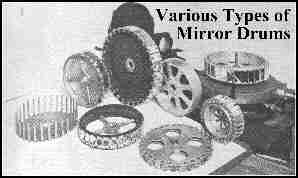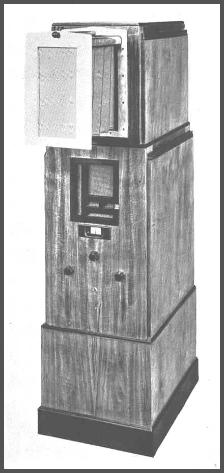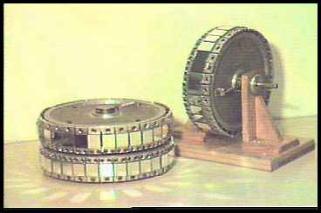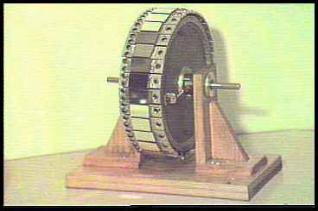|
Television Experimenters.com
The Mirror Drum
Mirror Drums
A very early improvement over the Nipkow disk was the Mirror drum. For its size, it was a very light efficient mechanical scanner. compared to the axis of the drum. For horizontal scanning, the mirror drum axle was supported in a vertical plane. Therefore for vertical scanning, the axle was horizontal. As it rotated, each mirror caused a line to be scanned below (horizontal scan) or beside (vertical scan) the previous one. The drawing shown below is of a basic vertically scanned mirror drum system. |
 |

|
In this drawing, the modulated light originates at a small aperture at the lower left, then passes through a projection lens. This lens is adjusted so that the the light at the aperture
itself is focused on the screen. Of course, in order for the light to get there, it must be reflected off of mirrors on the drum. The mirrors are thereby able to control the position of the light spot on the screen as it rotates. Since each mirror is carefully set at a different but proper angle, as the drum rotates, the and a second drum mounted at a right angle to the first, would provide the necessary vertical shift. |

|
The light source in large scale theater systems might Johnhave been a modulated arc or a standard arc lamp, the latter requiring a Kerr cell along with its associated components. In later years, the arc light would be replaced with powerful incandescent lamps. For receivers used in the home, crater arc lamps were able to provide sufficient image brightness.
On the left is a picture of a mirror drum receiver manufactured by John Logie Baird in 1932. It provided 30 line image of 9 inches by 4 inches. A larger version of this receiver produced a 14 inch by 6 inch picture. This receiver used a 100 watt incandescent lamp as a white light source, that was in turn modulated with the video signal by a Baird "Grid Cell". This was Baird's version of the Kerr cell.

|
Beyond 60 lines with mirrors of a reasonable size, the drum became tended to be large. The mirrors were also difficult to adjust. Shown in the two photos below are three examples recently made by Peter Yanczer of 32 line mirror drums. The mirrors are of the very efficient first surface variety and measure approximately one inch square.
|

|

|
The drum itself is nine inches in diameter. Each mirror has three adjustment screws. The drum is driven by its shaft through a tension spring. This allows the synchronous driving motor to uncouple from the heavy mass of the drum, during start up. Without this feature, some synchronous motors would not be able to reach their synchronous speed.
There was constant pressure to increase the number of lines in the image. However, this tended to increase the size of the scanning assembly as well the signal bandwidth requirements. Commercial television started with 24 line pictures, mostly because of the bandwidth limitations of transmitters operating in or just above the Broadcast Band. As the transmissions were allowed to move up in frequency, more lines could be added to the image, thereby improving image resolution. With pictures up to 60 lines, scanning disks/drums with holes, lenses or mirrors could provide acceptable pictures with disks of reasonable size. Beyond 120 lines, holes, lenses or mirrors became too small or the disk/drum too large and the requirement for manufacturing precision too great for scanning disks to see any further use in receivers. By 1932, the Nipkow disk and mirror drum had both pretty much had their day. This was also the end of the "low definition" era of television and the beginning of the "High Definition" era. |

All rights reserved.
|